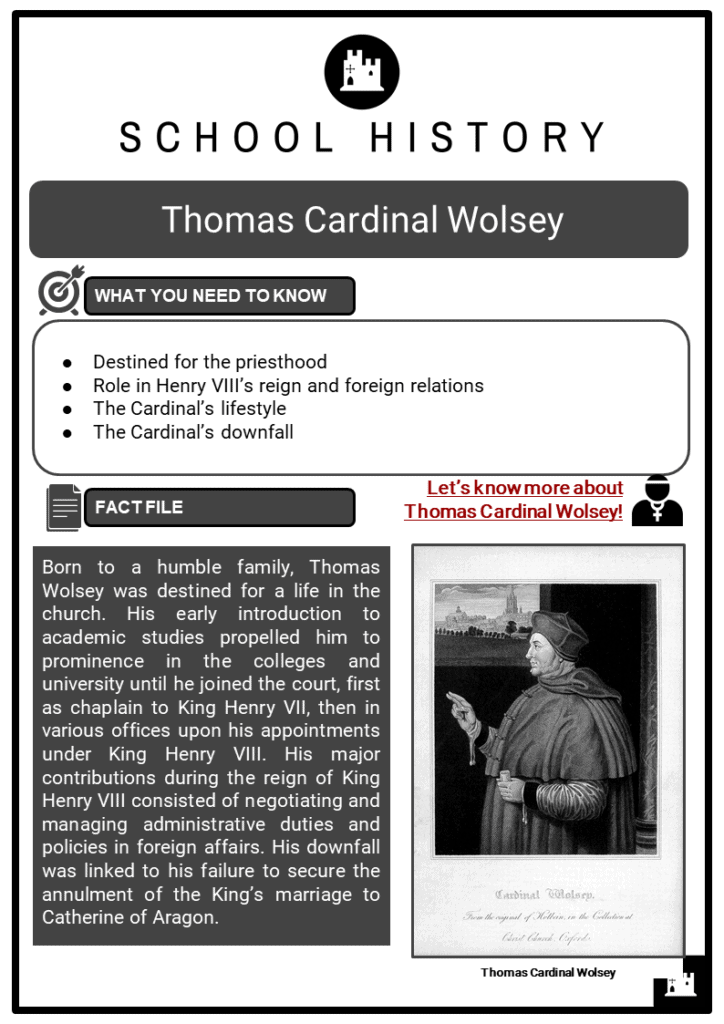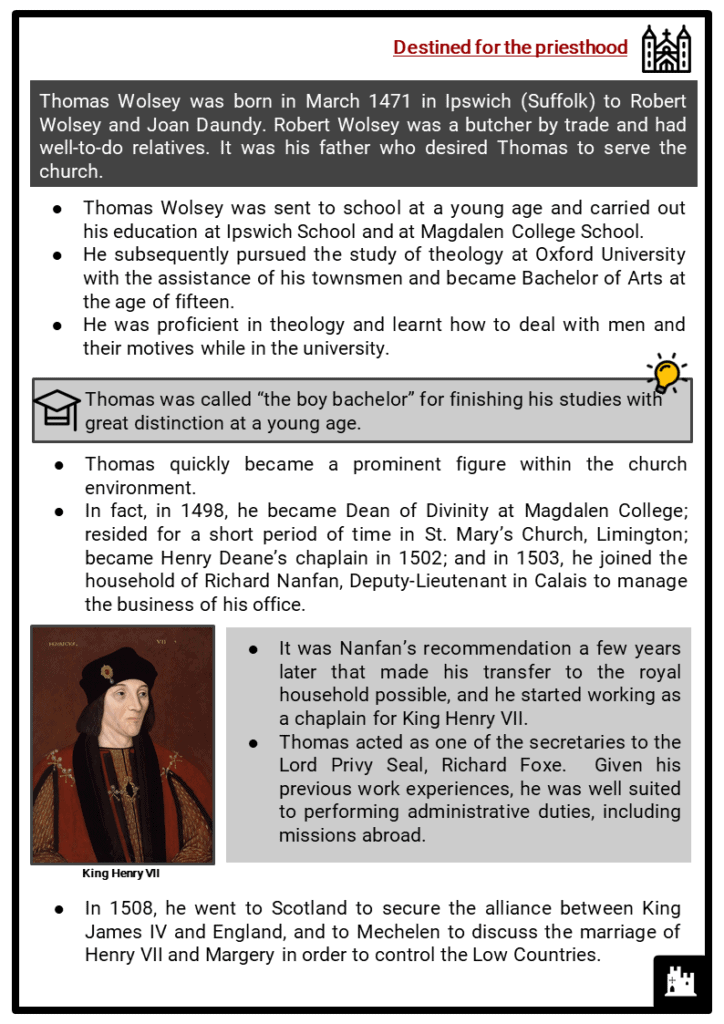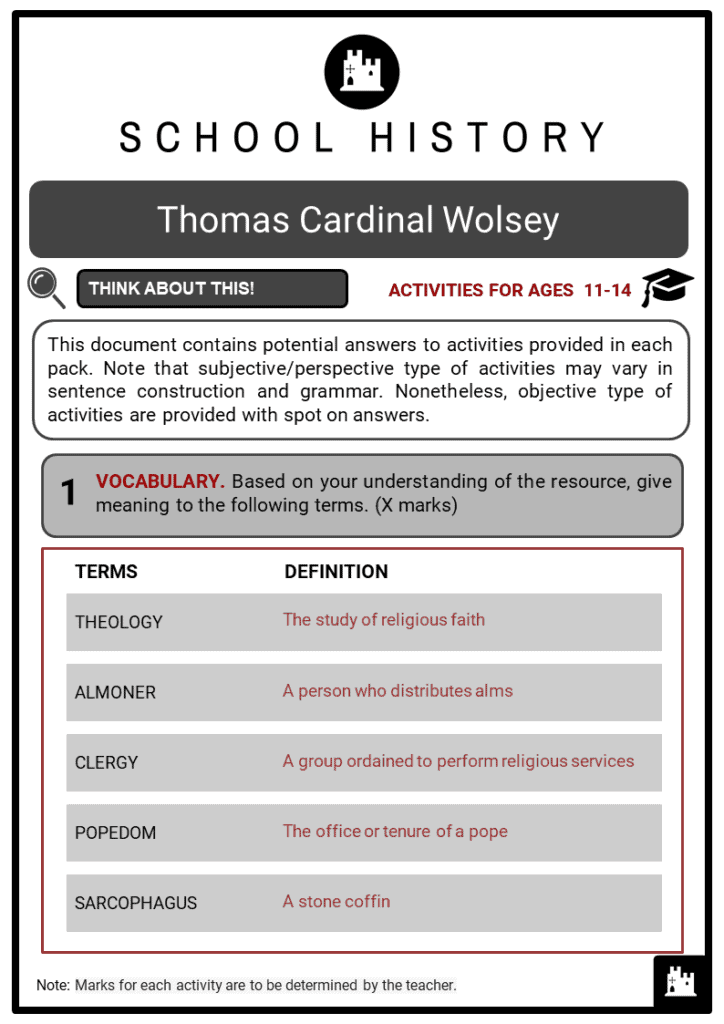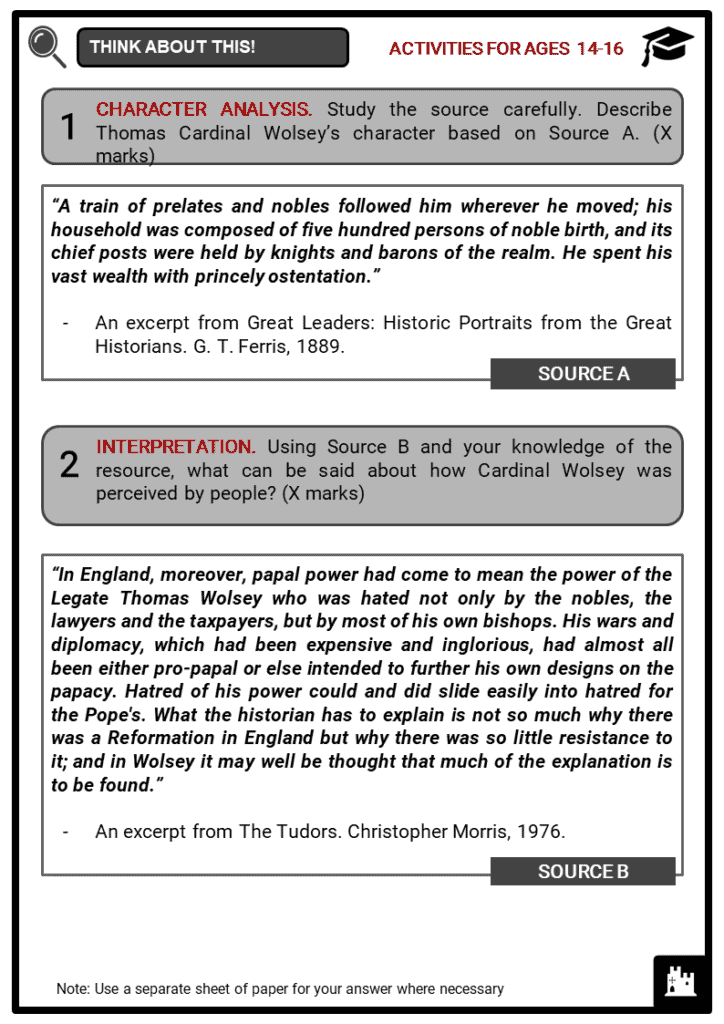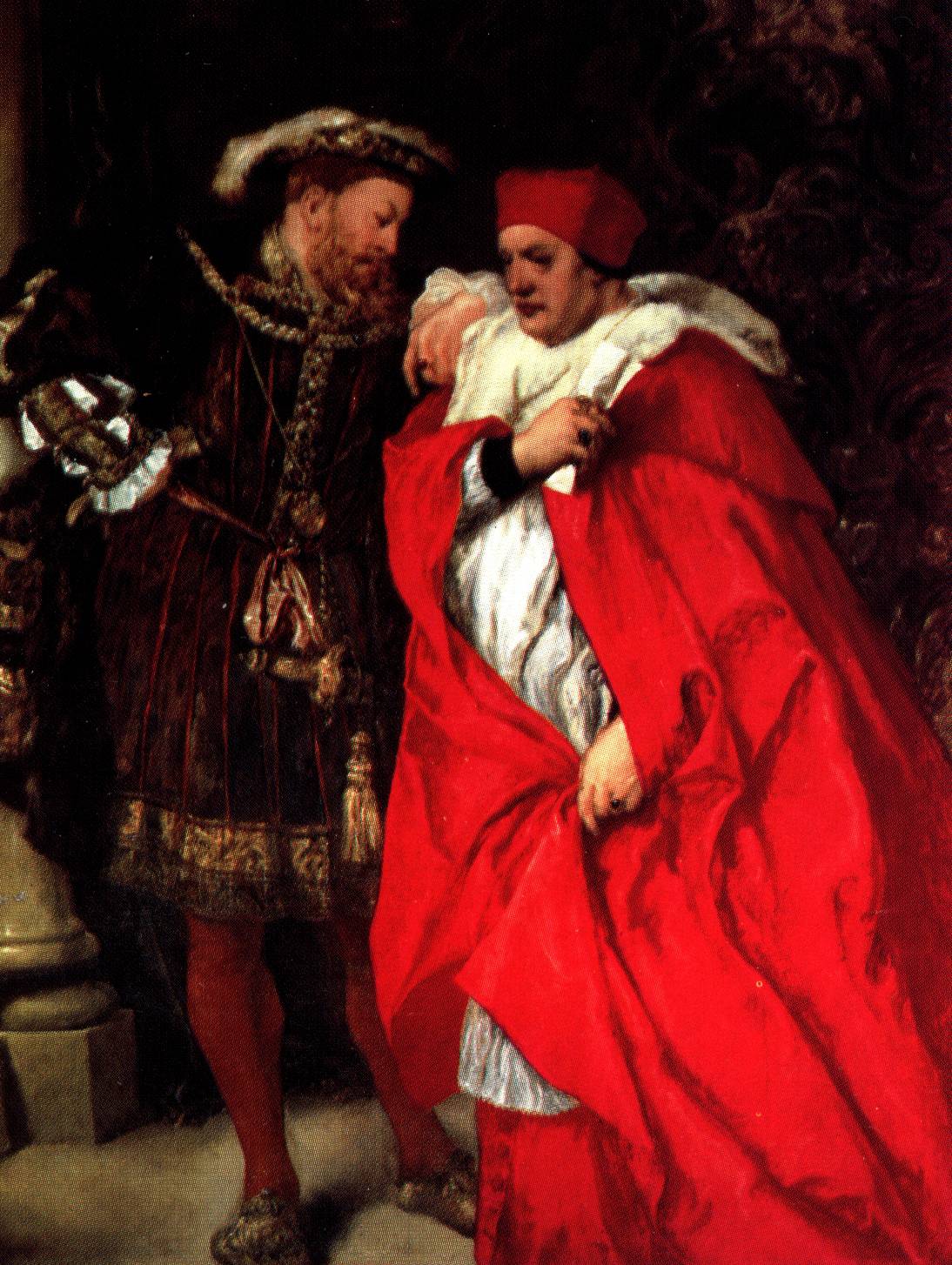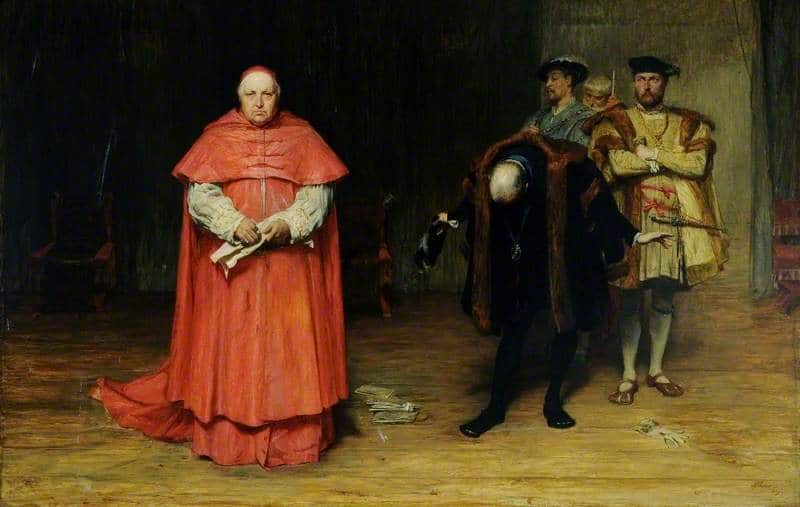Download Thomas Cardinal Wolsey Worksheets
Do you want to save dozens of hours in time? Get your evenings and weekends back? Be able to teach Thomas Cardinal Wolsey to your students?
Our worksheet bundle includes a fact file and printable worksheets and student activities. Perfect for both the classroom and homeschooling!
Table of Contents
Add a header to begin generating the table of contents
Summary
- Destined for the priesthood
- Role in Henry VIII’s reign and foreign relations
- The Cardinal’s lifestyle
- The Cardinal’s downfall
Key Facts And Information
Let’s know more about Thomas Cardinal Wolsey!
- Born to a humble family, Thomas Wolsey was destined for a life in the church. His early introduction to academic studies propelled him to prominence in the colleges and university until he joined the court, first as chaplain to King Henry VII, then in various offices upon his appointments under King Henry VIII. His major contributions during the reign of King Henry VIII consisted of negotiating and managing administrative duties and policies in foreign affairs. His downfall was linked to his failure to secure the annulment of the King’s marriage to Catherine of Aragon.
Destined for the priesthood
- Thomas Wolsey was born in March 1471 in Ipswich (Suffolk) to Robert Wolsey and Joan Daundy. Robert Wolsey was a butcher by trade and had well-to-do relatives. It was his father who desired Thomas to serve the church.
- Thomas Wolsey was sent to school at a young age and carried out his education at Ipswich School and at Magdalen College School.
- He subsequently pursued the study of theology at Oxford University with the assistance of his townsmen and became Bachelor of Arts at the age of fifteen.
- He was proficient in theology and learnt how to deal with men and their motives while in the university.
- Thomas was called “the boy bachelor” for finishing his studies with great distinction at a young age.
- Thomas quickly became a prominent figure within the church environment.
- In fact, in 1498, he became Dean of Divinity at Magdalen College; resided for a short period of time in St. Mary’s Church, Limington; became Henry Deane’s chaplain in 1502; and in 1503, he joined the household of Richard Nanfan, Deputy-Lieutenant in Calais to manage the business of his office.
- It was Nanfan’s recommendation a few years later that made his transfer to the royal household possible, and he started working as a chaplain for King Henry VII.
- Thomas acted as one of the secretaries to the Lord Privy Seal, Richard Foxe. Given his previous work experiences, he was well suited to performing administrative duties, including missions abroad.
- In 1508, he went to Scotland to secure the alliance between King James IV and England, and to Mechelen to discuss the marriage of Henry VII and Margery in order to control the Low Countries.
- He was then given the deanery of Lincoln before Henry VII died. It was Thomas’s former pupil, the young Marquess of Dorset who introduced him to the new King, Henry VIII. Thomas initially served as almoner and was called to the King’s council in 1511.
- From there, he climbed up the ladder to power. His career development, which further broadened his influence, consisted of appointments as registrar to the Order of the Garter in 1509, as Canon of Windsor in 1511, as Bishop of Lincoln in 1514, then as Archbishop of York that same year. He became Cardinal and Lord Chancellor in 1515, and Bishop of Durham in 1523. In essence, all his prestigious positions made him a wealthy and prominent man in England.
Role in Henry VIII’s reign and foreign relations
- Throughout the Anglo-French war between 1512 and 1514, Thomas demonstrated his great capability in dealing with foreign matters in a diplomatic manner and he shared the King’s enthusiasm for war.
- In fact, England was able to successfully defeat the French thanks to Thomas’s organisation and planning skills: he managed negotiations and encouraged the marriage between Mary Tudor and the French King Louis XII.
- When William Warham, Archbishop of Canterbury resigned from his post, Pope Leo X made Thomas Wolsey a Cardinal in September 1515.
- Under Henry V’s government, the King forbade individuals such as Henry Beaufort becoming Cardinals since that would have implied less religious authority for the King.
- The title ‘Cardinal’ was placed between the first name and surname following the tradition of how the nobility was referred to (the title and territory came after the baptismal name).
- However, in the era of Henry VIII, the King entrusted Thomas and fully accepted him as a Cardinal since he believed in his ability to manage the papal affairs in the King’s favour. Warham and Foxe, Henry VIII’s primary counsellors, fell from power when they opposed the King regarding the Anglo-French war.
- In 1518, Henry VIII made Thomas Papal Legate and assigned him the task of negotiating with twenty other countries.
- Thomas designed the Treaty of London which ended warfare within the states of Europe and brought peace, but only for a short period of time.
- Thomas planned and hosted the Field of the Cloth of Gold in 1520, to bring progress to the bond between the two monarchs, Henry VIII and Francis I of France.
- The meeting was extravagant and made a great impression but its political consequence was unsatisfactory.
- Moreover in 1520, Thomas began aiming for the Popedom. Charles V commended the Cardinals to Thomas’s election to the Papal chair but failed.
- Thomas repeatedly raised his intention but was disappointed each time.
- In 1523, the Pope acknowledged Thomas’s diplomacy within England and other European nations by nominating him Bishop of Durham. Then in 1524, Thomas was granted legate powers for life.
- In 1525, Thomas negotiated the Treaty of the More, which generally restored the friendship between England and France.
The Cardinal’s lifestyle
- Thomas Wolsey’s lifestyle was certainly not humble like his origins. In fact, being part of the highest ranks of the clergy allowed him to live in great luxury, dress in sumptuous clothes and surround himself with expensive items. Thomas had accumulated great wealth while the King used him as a powerful diplomatic and political tool.
- Thomas’s residence included five hundred people, and he also owned several houses. Some of the most important ones are those in Westminster, York Place, and Hampton Court.
- His residence in Hampton Court was built with the intention of hosting royal events, as well as welcoming foreign monarchs such as Charles V (1522), and other diplomats.
- On the other hand, York Place was created for the Cardinal to carry out his work for Westminster.
- Thomas was regarded as the ‘alter rex’, i.e. the other king because of his prominence in England and throughout Europe.
The Cardinal’s downfall
- The origin of Cardinal Wolsey’s downfall was linked to Henry VIII’s desire to be married to Anne Boleyn. Henry VIII sought to be divorced from Catherine of Aragon, who failed to provide him with a male heir. Thomas willingly consented to solve the King’s problem at hand but failed due to circumstances he had no control of.
- Thomas turned to the Pope in order to annul the marriage. He claimed to the Pope that the annulment of the marriage should be discussed at a trial in England and that the outcome should be decided by Thomas himself as the Papal Legate.
- The Pope at that time, Clement VII, agreed with Thomas’s suggestion to deal with the case in England, but only in the presence of another Papal Legate, Cardinal Campeggio. However, Campeggio’s arrival in England kept being delayed.
- Henry VIII’s marriage annulment had started in 1527, and the Pope as well as the Papal Legate, Campeggio, managed to halt the proceedings for two years. Finally, in 1529, the hearing was held at Blackfriars.
- Catherine of Aragon did not want to divorce from Henry VIII and in court she gave the speech of her life, in which she asked the King for mercy.
- The Pope closed the English trial in favour of Catherine of Aragon and concluded that the next hearing could be held only in Rome. However, another hearing in Rome never came about.
- Moreover, the nobles of Norfolk, Suffolk, and Rochford took the opportunity to depict Thomas in a negative light, making him seem like a scheming man who had deliberately misled the King.
- As soon as the dukes managed to turn the King against Thomas, that was the beginning of his end. The dukes of Norfolk and Suffolk even took over his household in York Place and sacked clothes, silver, and linen.
- Thomas’s fault lay in his inability to convince the Pope in the annulment of Henry VIII’s marriage, and Anne Boleyn desired to be avenged. Anne Boleyn was more than happy to join the dukes with their destruction of the Cardinal.
- In 1529, Thomas Wolsey was denied his government office and his properties were confiscated by the King. He was left with only the title of Archbishop of York.
- Notwithstanding the rage he had provoked in Henry VIII, Anne Boleyn, and the dukes of Norfolk and Suffolk, he did not receive the death penalty: he was solely accused of treason.
- The same year, the former Cardinal undertook a journey to York. However, on his way back to the capital, he fell ill and ultimately died in Leicester on 29 November 1530. He was only fifty-seven years old.
- When he was still alive, the Cardinal assigned to Thomas Cromwell the task of directing Italian architects and artists in the construction of a grand black marble sarcophagus, where he intended to be buried.
- However, following his failure in serving the King, he was denied such a beautiful burial and his body was laid to rest within the walls of Westminster Abbey. His sarcophagus became Horatio Viscount Nelson’s tomb.
Image sources:
[1.] https://upload.wikimedia.org/wikipedia/commons/c/c8/Cardinal_Thomas_Wolsey._Wellcome_L0002786.jpg
[3.] https://upload.wikimedia.org/wikipedia/commons/5/52/The_Disgrace_of_Cardinal_Wolsey.jpg

